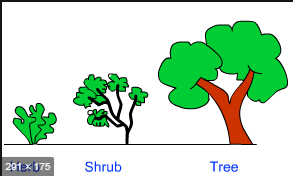What is Difference Between Herbs And Shrubs?
Difference Between Herbs And Shrubs is that In the plant world, several types of plants can be recognized according to their characteristics. In fact, plants can be classified by their size and, in general, anyone can easily recognize the differences that exist, for example, between a cactus and a tree. However, the differences in size are not always as noticeable, so in some cases, it is not easy to know if a particular plant belongs to one group or another.
One of the problems when buying a plant is that you are not very clear about the difference of what would be a tree, a bush and a grass, or if you have it but after buying that plant you realize that it has been a bad choice, well because you have placed it near a fence and it is breaking, because you did not want it to extend too much, etc.
That’s why we want to give you the most differentiating feature you can find.
The trees have a thick and hard stem called a trunk from which, at some distance from the ground, it begins to branch. Most of the trees have roots that expand not only vertically but also horizontally except for cypresses (hence they are found more in cemeteries because they only enrich downward, not sideways).
The bushes, on the other hand, can have one or two hard stems from which the branches leave almost at ground level. They tend to branch a lot from there that if you want to have space, it is best not to have these bushes and the same thing if you want to cover something that is at a certain height.
Finally, herbs have a thin and flexible stem that makes it split very easily
Plants can be grouped or classified according to their size in trees, shrubs, bushes or sub-bushes and herbs. Below is a brief overview of each of them with their corresponding differences.
Trees
Trees are perennials that have the woody trunk and branch at a certain height from the ground. They are considered as woody plants due to the fact that both their trunk and their branches undergo lignification, resulting in an increase in their diameter. The strength and lignification of its branches and trunk make the growth of trees much greater than that of other plants and thus can support the great weight of their canopies. In general, trees refer to plants that exceed 5 meters in height and can be very long-lived.
In trees, the growth in length is carried out almost exclusively in the apical buds and in the buds of the upper lateral shoots. The largest living beings on the planet belong to this group, such as sequoia trees, whose record reaches 135 meters high.
On the other hand, within this group of plants, there are two basic forms of growth: monophonic and sympathetic. Monopodial or monopodial growth trees are characterized by having a main vertical stem that never interrupts their growth and lateral branches emerge from it, it is the typical growth of conifers such as pines. Sympathetic or sympodial growth trees have the main axis that can interrupt their growth, branching occurs from this axis and, in turn, branches branch over and over again.
Shrubs and their differences with trees
The bushes are woody and perennial plants. As with trees, they are woody plants because both their trunk and branches undergo lignification. Shrubs are considered to have developed different ways of growth and life. They usually have many roots and are smaller than trees (they measure between 1 and 3 meters).
The most noticeable difference between a tree and a bush is that the latter begins to branch out from the base and not at a certain height of the trunk as it occurs in trees; not existing, then, clear differentiation of the trunk and the crown as in the trees.
In the bushes, the growth is encouraged by the buds close to the ground and those that are arranged at the top retard their development. Despite this, the differences between trees and shrubs are still considered very arbitrary. According to environmental conditions, the same species could develop as a tree or shrub. There are numerous cases in nature: the species Salix fragilis (wicker), Salix alba (willow), Lauris nobilis (laurel), Punica granatum (pomegranate) and Sambucus nigra (elderberry) are examples of them, these can be found both in shrub-like form of large trees. Difference Between Herbs And Shrubs
You May Also Interested:
